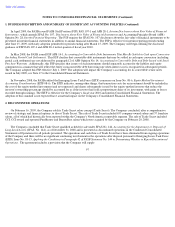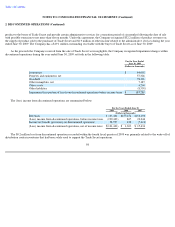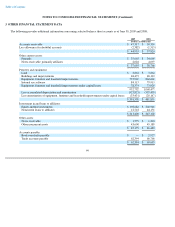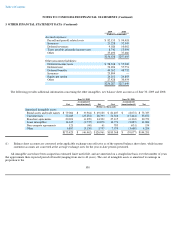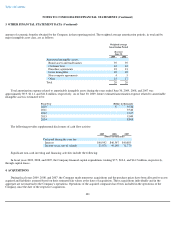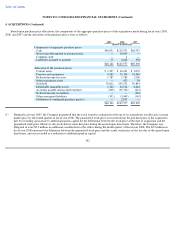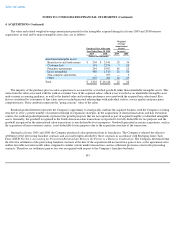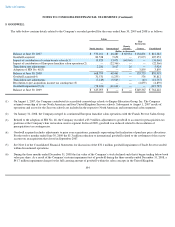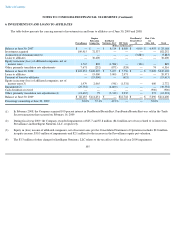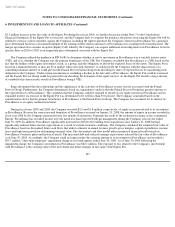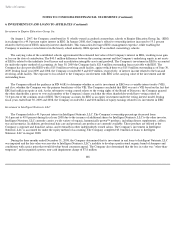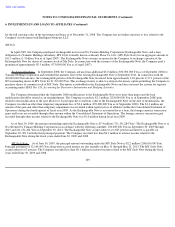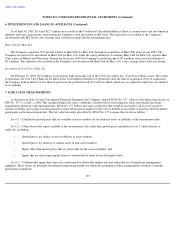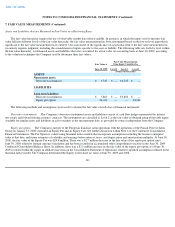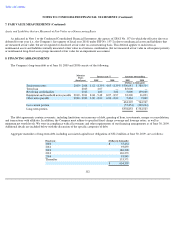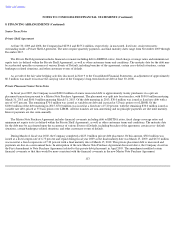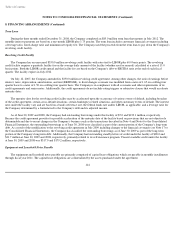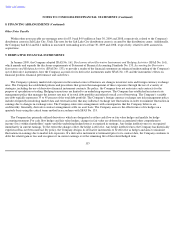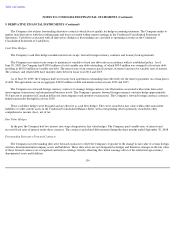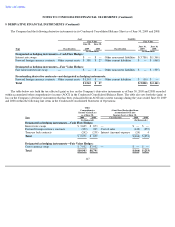Supercuts 2009 Annual Report Download - page 109
Download and view the complete annual report
Please find page 109 of the 2009 Supercuts annual report below. You can navigate through the pages in the report by either clicking on the pages listed below, or by using the keyword search tool below to find specific information within the annual report.
Table of Contents
NOTES TO CONSOLIDATED FINANCIAL STATEMENTS (Continued)
6. INVESTMENTS IN AND LOANS TO AFFILIATES (Continued)
$2.1 million increase in the fair value of the Equity Put during fiscal year 2009, see further discussion within Note 7 to the Consolidated
Financial Statements. If the Equity Put is exercised, and the Company fails to complete the purchase, the parties exercising the Equity Put will be
entitled to exercise various remedies against the Company, including the right to purchase the Company's interest in Provalliance for a purchase
price determined based on a discounted multiple of the earnings before interest and taxes of Provalliance for a trailing twelve month period. The
merger agreement also contains an option (Equity Call) whereby the Company can acquire additional ownership interest in Provalliance between
specific dates in 2018 to 2020 at an acquisition price determined consistent with the Equity Put.
The Company utilized the guidance in FIN 46(R) to determine whether or not its investment in Provalliance was a variable interest entity
(VIE), and if so, whether the Company was the primary beneficiary of the VIE. The Company concluded that Provalliance is a VIE based on the
fact that the holders of the equity investment at risk, as a group, lack the obligation to absorb the expected losses of the entity. The Equity Put is
based on a formula that may or may not be at market when exercised, therefore, it could provide the Company with the characteristic of a
controlling financial interest or could prevent the Franck Provost Salon Group from absorbing its share of expected losses by transferring such
obligation to the Company. Under certain circumstances, including a decline in the fair value of Provalliance, the Equity Put could be exercised
and the Franck Provost Group could be protected from absorbing the downside of the equity interest. As the Equity Put absorbs a large amount
of variability this characteristic results in Provalliance being a VIE.
Regis determined that the relationship and the significance of the activities of Provalliance is more closely associated with the Franck
Provost Group. Furthermore, the Company determined, based on a quantitative analysis that the Franck Provost Group has greater exposure to
the expected losses of Provalliance. The variability that the Company could be required to absorb via its equity interest in Provalliance and its
expanded interest via exercise of the Equity Put was determined to be well less than 50.0 percent. The Company concluded based on the
considerations above that the primary beneficiary of Provalliance is the Franck Provost Group. The Company has accounted for its interest in
Provalliance as an equity method investment.
During fiscal years 2009 and 2008, the Company recorded $2.0 and $1.8 million, respectively, of equity in income related to its investment
in Provalliance. Because the transaction and formation of Provalliance occurred on January 31, 2008, the amount of equity in income recorded in
fiscal year 2008 by the Company represented only five months of operations. Primarily the result of the weakened economy across continental
Europe, Provalliance has recorded income at levels much less than expected by Regis management during the Company's fiscal year ended
June 30, 2009. In addition, Provalliance significantly increased its debt levels resulting from acquisitions since January 31, 2008 but had
significantly reduced future income expectations as a result of current economic conditions. The Company calculated the estimated fair value of
Provalliance based on discounted future cash flows that utilize estimates in annual revenue growth, gross margins, capital expenditures, income
taxes and long-term growth for determining terminal value. The discounted cash flow model utilizes projected financial results based on
Provalliance's business plans and historical trends. The increased debt and reduced earnings expectations reduced the fair value of Provalliance
as of June 30, 2009. Accordingly, the Company could no longer justify the carrying amount of its investment in Provalliance and recorded a
$25.7 million "other-than-temporary" impairment charge in its fourth quarter ended June 30, 2009. As of June 30, 2009 following the
impairment charge, the Company's investment in Provalliance was $82.1 million. The exposure to loss related to the Company's involvement
with Provalliance is the carrying value of the investment and future changes in fair value of the Equity Put.
107


